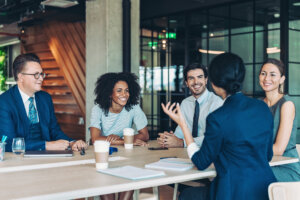How to Use Conflict to Drive Engagement & Results

I was once asked to speak to a large group of sales managers, and when I asked if there was a topic that they had in mind, the event organizers asked if I could speak on how to have a difficult conversation. As part of my pre-event preparation, I asked if I could talk to some sales managers who would be in that audience. I asked that group if any of them had a difficult conversation they needed to have with someone on their team that they were avoiding. What I learned took me by surprise; the majority of them said yes.
Why We Struggle
When I asked why these leaders struggle with the difficult conversation, I was told they do not want to get into conflict with people on their team. One leader even explained that her typical day had enough trouble of its own without starting up something with one of her subordinates. While I could understand what they were telling me, I know that this is no way to lead. It will have long-term adverse effects on the engagement level of your team and on the results you hope to deliver.
Embracing Conflict to Drive Results
While some leaders may prefer to avoid or delay potential conflict with someone on their team, some long for it. I worked with one executive who was proud of the ease with which we engaged in conflict with others. Both types of leaders place the engagement of the team and your results at risk. To be a leader who can turn conflict situations into positive outcomes, consider these three strategies:
- Balance CARE and CANDOR. If you are a strong relational leader, you most likely have a caring approach to leading and tend to avoid or delay candor or straight talk. If you are a strong production or task-based leader, you most likely embrace candor and minimize exhibiting care in your conversation. Instead, both leaders should balance care and candor. If you exhibit all care and no candor, you will create a dysfunctional relationship – things are never ALL GOOD. If you exhibit all candor and no care, you will create a distant relationship – no one wants to be around you.
- Always maintain MUTUAL PURPOSE and MUTUAL RESPECT. I first learned this from the authors of Crucial Conversations Tools for Talking When Stakes Are High. Authors Patterson, Grenny, McMillan, and Switzler teach that there can be no safe environment for productive conversation if both parties in the conflict don’t practice mutual purpose and mutual respect. If we are trying to get to the same outcome and we exhibit respect for each other, almost anything is possible.
- What you CREATED, what you ALLOW to be. This idea comes from Dr. Henry Cloud in his book, Boundaries for Leaders: Results, Relationships, and Being Ridiculously in Charge. Dr. Cloud asserts that the situation you have today, whether positive or negative, is the result of two things; what you have created and what you have allowed to be. If you want to enjoy a positive, result-driven culture, then you need to create an environment of straight talk and accountability, and not allow difficult situations to linger unaddressed.
Taking complete ownership of conflict and tense situations on your team will require intentional action on your part as the leader. When you avoid conflict or delay in addressing situations that may involve conflict, you are communicating that you will allow certain behaviors. You can create an environment of uncertainty and distrust, and that’s the last thing you want to do as a leader.
_____________________________
Crucial Conversations Tools for Talking When Stakes Are High, by Kerry Patterson, Joseph Grenny, Ron McMillan, Al Switzler, Copyright 2012, McGraw-Hill Publishing
Boundaries for Leaders: Results, Relationships, and Being Ridiculously in Charge, by Dr. Henry Cloud, Copyright 2013, HarperCollins Books
About Perry Holley
Perry Holley is a coach and facilitator with Maxwell Leadership’s Corporate Solutions Group as well as a published author. He has a passion for developing others and seeing people grow into the leaders they were intended to become.
More Articles

Finding Time for Leadership: 5 Ways to Lead Effectively on a Tight Schedule

Inspiring Stories of Leadership Coaching in Action









Be the first to comment on "How to Use Conflict to Drive Engagement & Results"